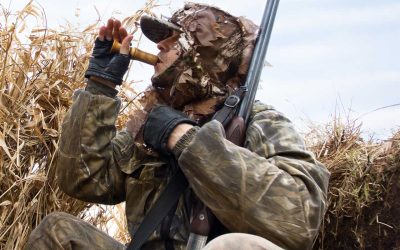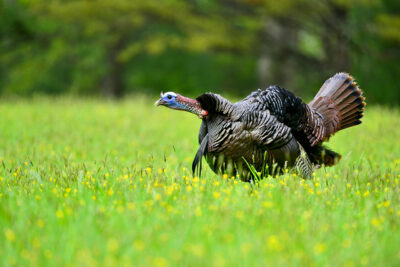By Paul Rackley, GunBroker.com Editor

With spring coming fast, hunters are getting excited for turkey hunting. The early turkey season seems to be the best time to fill a tag, and it is for most hunters. The birds haven’t been pushed around relentlessly, so they gobble more freely and are more active.
This doesn’t mean, though, that hunters don’t have to have a plan. Even before pressure shuts them down, turkeys have an almost sixth sense for when something is wrong. Sure, some hunters just get lucky. Most of us, however, have to put in the work to get a head in our sights.
Scout it Out
There is a reason why scouting is discussed so often. It is one of the most important factors in being successful in the turkey woods. It is also one of the few factors that is almost completely controlled by the hunter. Hunters that put in the time have a much higher expectation of success.
Start with topographical maps, looking for likely starting points. These include hills in the middle of properties, creek banks and anything else that can funnel birds. Those who can’t find the time to actually walk the property can mark likely areas on a GPS unit for finding the spot in the dark. Once there, get quiet, let the woods settle down and listen hard as the sun starts to peek over the horizon.
Savage 301 Turkey

In most turkey hunting situations, a single shot determines success or failure. With that in mind, a single shot shotgun, like the Savage 301 Turkey, makes a lot of sense. This is especially great for a person who wants something lightweight for all day carry. With multiple versions from which to choose, the 301 Turkey comes in three gauges (12, 20, .410) with a couple of different Mossy Oak camo options, two optic options and even a thumbhole stock. Those without optics come with a rail for adding them later, and all turkey models come with an extra full choke for use with turkey loads.
Making the Call
There are numerous theories on calling in the early season. Lots of hunters prefer to go light to keep other hunters from zeroing in on the bird. However, it can be a good idea to hammer a roosted bird. This can make the gobbler think that you’re ready, willing and able. He just might jump right on down and roll into range.
Sure, you can start soft and gentle, but if that isn’t working, change it up. Every bird responds differently, depending on the situation, which can change quickly. If soft and slow isn’t working, get fired up and cut him off when he’s gobbling. There isn’t a single sure method to calling. Be prepared to change calls, cadence and tone.
Swapping up calls and location can also work against tough toms. If a bird isn’t coming, try moving around a little bit and changing up calls. Go from a box to a pot and peg or even a mouth call. This is one of the main reasons hunters typically carry multiple calls during the season. No one knows for sure what makes a gobbler interested. So, it is smart to have many options with which to try.
Mossberg Silver Reserve Eventide Turkey

Sometimes gobblers stop at about 40 yards to gobble strut and drum, providing the perfect shot. Other times birds charge in so fast they get inside the optimal zone for turkey loads and chokes. That’s when a shotgun like the Mossberg Silver Reserve Eventide makes a lot of sense. This double-barrel shotgun provides the option of using two different chokes. One can be set up with an extra full for reaching out while the other can have something wider in case they get close. The Eventide comes available in 12, 20 and 28 gauges in Mossy Oak Greenleaf camo. It also comes with three chokes, two extra full and one improved cylinder, providing options. Other features include a 20-inch vent-rib barrel, fiber-optic front sight and tang-mounted safety/barrel selector.
Move Selectively
Running and gunning is fast paced and lots of fun. But it can also be counterproductive, especially during the early turkey season. There aren’t a lot of leaves and foliage blocking views. This can allow hunters to see birds coming. It also allows birds to see movement. And their eyesight is way better than ours. Pushing too hard and fast can bump birds, ending all chances with that gobbler.
Before relocating on a bird, make sure it isn’t just over a hill, making his gobble sound farther away, heading your way. Also make sure that there isn’t a hen nearby ready to sound off with the dreaded putt, ruining the whole situation. This doesn’t mean that moving on a bird is bad. Hunters just need to understand the dangers and only move when required.
Benelli Super Nova Pump

When Benelli brought out a pump, shooters were surprised; Italian companies never seemed to care about pumps. Shooters were also surprised by the Nova’s one-piece, polymer stock and receiver. In the Nova, Benelli used a rotary bolt that locks directly into the barrel. In addition to removing metal, which equals weight, the rotary bolt provides a quick, smooth pump stroke. It also reduced costs, allowing more American shooters to purchase Italian shotguns. The Nova comes in either 12 or 20 in a couple of different camouflages or black synthetic, which is the best deal of course. It also comes with three chokes (IC, M, F), magazine cutoff and a red-bar front sight. The only problem is that the Nova is not the lightest pump on the market.
Early Turkey Season Decoys
While using decoys aren’t a requirement, they can be handy tools. Decoys provide something for gobblers to focus on when coming into range. This can be very handy against a wary bird. Decoys can also help some birds to commit. However, decoys can also make birds lock up if not used properly.
It’s real easy to carry a single hen decoy in a vest. But just simply setting it out in front might not be the best idea. In the turkey world, hens typically travel to toms, not the other way around. Lots of toms like to come in most of the way and then have the hen close the final distance. This keeps them just out of range. Instead of out front, consider setting the decoy to the side and behind. This sets the gobbler to walk past or at least come into range before stopping.
Adding a jake can really help, especially where they can be seen from a distance. Jake decoys release the dominant trait in gobblers, making them mad about interlopers. Hunters can use a jake decoy in a lot of different ways. It can be placed close by, as if he is courting the gal or gals. Or, at a distance like the jake is trying to beat the gobbler to the game. This is a good time to try a jake gobble, but always keep safety in mind using these tactics.
Tristar Viper Max Semi-Auto

Some hunters want lightweight; others prefer recoil management, especially with heavy turkey loads. Of course, semi-auto shotguns can run well over a grand, which make the Tristar Viper Max a pretty good deal. This gas-operated shotgun comes with a variety of features despite its lower price. These include a vent rib with a matted sight plane, fiber-optic front sight, chrome-lined barrel and chamber, and quick plug removal. It also has a magazine cutoff and comes with four Beretta/Benelli style chokes. Unfortunately, hunters will have to purchase an extra-full choke for turkeys. But that is not a huge deal for a shotgun that costs much less than the typical semi-auto.
Gobble Em’ Up
Good calling is an artform, but bad calling brings birds in just as well. Every diehard turkey hunter has a story about the worst calling ever that ended up being a real hen. Hunters need to know how to make yelps, clucks, cutts and purrs. It also not a bad idea to be able to create a half decent gobble.
Some people are completely against gobbling to turkeys, saying it is not safe. And it can bring the wrong attention. However, used sparingly and wisely, it can be a game changer. All males are naturally competitive, and turkeys are no different. If a gobbler thinks another male might beat him to the girl, he can lose all sensibility and come a running.
The early turkey season is the last hunting opportunity before summer and fishing. In fact, lots of hunters head to waters for crappie when birds go silent. So those interested in tagging a gobbler before fishing had better hit early turkey season.
Related Video: Hunting During the Frontier Era
Related Article: Building an Unstoppable Hog Hunting Rifle
Related Article: The Guns You Want to Pack for Your Next Alaskan Hunting or Fishing Trip




![Benelli M2 Field Shotgun [Video]](https://content.gunbroker.com/wp-content/uploads/2023/02/Benelli_M2-right-facing-angle-1200-X-800-400x267.jpg)
![All the Beretta Shotguns Released in 2023! [Video]](https://content.gunbroker.com/wp-content/uploads/2023/04/Beretta-2-1200-X-800-400x267.jpg)
